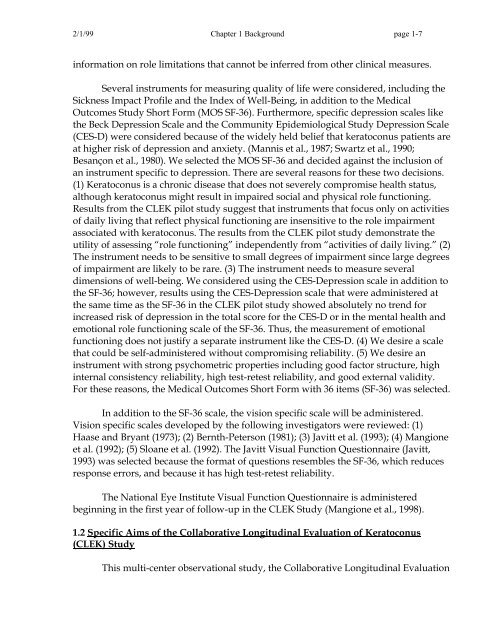OM t of c.iii - Vision Research Coordinating Center - Washington ...
OM t of c.iii - Vision Research Coordinating Center - Washington ...
OM t of c.iii - Vision Research Coordinating Center - Washington ...
Create successful ePaper yourself
Turn your PDF publications into a flip-book with our unique Google optimized e-Paper software.
2/1/99 Chapter 1 Background page 1-7<br />
information on role limitations that cannot be inferred from other clinical measures.<br />
Several instruments for measuring quality <strong>of</strong> life were considered, including the<br />
Sickness Impact Pr<strong>of</strong>ile and the Index <strong>of</strong> Well-Being, in addition to the Medical<br />
Outcomes Study Short Form (MOS SF-36). Furthermore, specific depression scales like<br />
the Beck Depression Scale and the Community Epidemiological Study Depression Scale<br />
(CES-D) were considered because <strong>of</strong> the widely held belief that keratoconus patients are<br />
at higher risk <strong>of</strong> depression and anxiety. (Mannis et al., 1987; Swartz et al., 1990;<br />
Besançon et al., 1980). We selected the MOS SF-36 and decided against the inclusion <strong>of</strong><br />
an instrument specific to depression. There are several reasons for these two decisions.<br />
(1) Keratoconus is a chronic disease that does not severely compromise health status,<br />
although keratoconus might result in impaired social and physical role functioning.<br />
Results from the CLEK pilot study suggest that instruments that focus only on activities<br />
<strong>of</strong> daily living that reflect physical functioning are insensitive to the role impairment<br />
associated with keratoconus. The results from the CLEK pilot study demonstrate the<br />
utility <strong>of</strong> assessing “role functioning” independently from “activities <strong>of</strong> daily living.” (2)<br />
The instrument needs to be sensitive to small degrees <strong>of</strong> impairment since large degrees<br />
<strong>of</strong> impairment are likely to be rare. (3) The instrument needs to measure several<br />
dimensions <strong>of</strong> well-being. We considered using the CES-Depression scale in addition to<br />
the SF-36; however, results using the CES-Depression scale that were administered at<br />
the same time as the SF-36 in the CLEK pilot study showed absolutely no trend for<br />
increased risk <strong>of</strong> depression in the total score for the CES-D or in the mental health and<br />
emotional role functioning scale <strong>of</strong> the SF-36. Thus, the measurement <strong>of</strong> emotional<br />
functioning does not justify a separate instrument like the CES-D. (4) We desire a scale<br />
that could be self-administered without compromising reliability. (5) We desire an<br />
instrument with strong psychometric properties including good factor structure, high<br />
internal consistency reliability, high test-retest reliability, and good external validity.<br />
For these reasons, the Medical Outcomes Short Form with 36 items (SF-36) was selected.<br />
In addition to the SF-36 scale, the vision specific scale will be administered.<br />
<strong>Vision</strong> specific scales developed by the following investigators were reviewed: (1)<br />
Haase and Bryant (1973); (2) Bernth-Peterson (1981); (3) Javitt et al. (1993); (4) Mangione<br />
et al. (1992); (5) Sloane et al. (1992). The Javitt Visual Function Questionnaire (Javitt,<br />
1993) was selected because the format <strong>of</strong> questions resembles the SF-36, which reduces<br />
response errors, and because it has high test-retest reliability.<br />
The National Eye Institute Visual Function Questionnaire is administered<br />
beginning in the first year <strong>of</strong> follow-up in the CLEK Study (Mangione et al., 1998).<br />
1.2 Specific Aims <strong>of</strong> the Collaborative Longitudinal Evaluation <strong>of</strong> Keratoconus<br />
(CLEK) Study<br />
This multi-center observational study, the Collaborative Longitudinal Evaluation
















